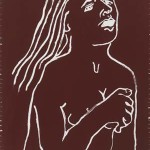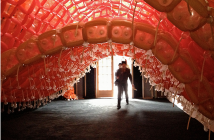By KAREN SCHIFF
When you walk into the Allston Skirt Gallery this month, it looks as if Roberta Paul's spin on "Creation : Science" is all mapped out. Her exhibition's title suggests a fundamental Question: Who gets the final word on the cosmos -- theologians or astronomers? And on the wall opposite the entrance appears Paul's diptych of paintings, as big as an Answer. One panel features Adam and Eve, larger than life, wailing and covering themselves (in an image patterned after Massaccio's "Expulsion of Adam and Eve from Paradise"). To their left is a panel that looks like a starry night sky. OK...creation (i.e., Bible stories) on the one hand, science (the results of Paul's star research) on the other. Paul gives ample room to both theology and astronomy, and so far they're taking sides.
But wait... not so fast. Paul calls the Adam and Eve panel "Expulsion: November 12, 3761 B.C.E.," lending the event a deterministic, rather than a mythological, flavor. And the starry panel on the so-called "science" side is called "Serpens Caput" -- ‘serpent's head' -- after the Latin name for the area of the sky she has painted, reminding us that the Genesis story crops up in even the most precisely denotative discourse. But are stars ever really so non-mythological, anyway? The night sky is full of allusions to ancient stories, and early astronomy overlapped liberally with astrology. And indeed, Paul's skies are poetically painted, just as her biblical images have a quasi-scientific twist of unflinching scrutiny. Another starry field appears behind the figures of Adam and Eve, so that the two so-called "sides" are actually mixing on the canvas, too.
Roberta Paul doesn't just want it both ways; she implies that it's impossible to have it otherwise. Titles of other pieces invite us to see her images through a productively ambiguous lens. Paul's starry field of "Dust" could be interstellar detritus, like the stuff she sees in her telescope, just as easily as it could be the Old Testament dirt unto which we will return. And what kind of "Knowledge" are the people so upset about, in the painting that hangs behind the gallery desk? The painting is a closeup of Adam and Eve, and as such, we can assume what they now "know" about good and evil (and body parts!). As a sensitive study of woeful facial expressions, however, the painting made me think about other ways that we use the word "knowledge" today. It gave me chills to consider that some kinds of "critical" knowledge that we now value -- verified statistical data, skillful reinterpretations, and thoroughgoing skepticism, to name a few examples -- can also sometimes lead us into (existential) sorrow.
Still, the real chills in this exhibition come from the paint. I have called Paul's fields "starry" because her brushstrokes suggest but do not depict "stars." Each "star" appears as a loose egg-shaped line, its wavering contours recalling the shaky shapes in Paul's earlier paintings of clocks (as drawn by her ailing, neurologically impaired father). Paul makes these gestures in light candy colors of gouache, and the flat monotone background of each canvas is in a dusky blue hue just distinct enough from the next so that the room pulses with intergalactic space. The lines of her figures look as rough and crisp as woodcuts, which gives them a stark intensity. In the back room, which at first reads like the "B side" of the exhibition (an older Expulsion scene; a variety pack of smaller starry fields with different color schemes, formats and techniques), some of her zippiest skies are achieved with a resist technique. But Paul's painterly skill comes through most vividly in the front room, where several large expanses of night sky fill the walls. The sense of three-dimensionality (strangely oscillating with superflat) is constructed not just through the sizes and colors of the "stars," but most importantly through her handling of the paint. Some of these shapes are thickly painted, with a slow and heavy hand...others show a range of weights and expressions, as if Paul is revealing something through indecipherable calligraphic strokes. And still others have a touch so quick and light that their presence becomes almost imperceptible, as elusive as the truth.
- Roberta Paul, Eve, latex on paper, 2007
- Roberta Paul, Expulsion November 12, 3761 BCE (detail), gouache and latex on paper, 2007
"Roberta Paul - creation : science" is on view June 1-30, 2007 at Allston Skirt Gallery.
All images are courtesy of the artist and Allston Skirt Gallery.






